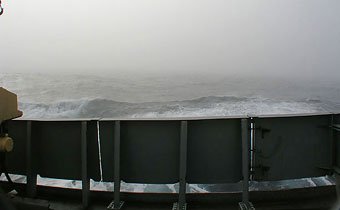

 | |||||||||
|
|
Journals 2006/2007Miriam Sutton
August 14, 2006 AM Location: Slope off of Nain Bank (57° 02' 16.06" N, 58° 39' 47.29" W) Coring continued through the day as the seas rocked the CCGS Hudson and her crew from starboard to port and back again. It is amusing to observe the scientists swaggering through the corridors, trying to safely walk from one deck to another. Our best attempts often leave us grasping for railings or each other for a little added stability. (See Troubled Seas photo below.)
Seasickness has not been an issue for any of us and we are all certainly grateful for that. Seasickness is a form of motion sickness which is often experienced during times at sea. Some people experience motion sickness in airplanes, on amusement park rides, or even in an automobile. The Seasickness, or motion sickness, is actually caused by confusion between the physical stimulus sent from your inner ear to your brain and the way that your brain interprets that stimulus. The inner ear contains a structure known as the cochlea that is filled with fluid. The fluid inside the cochlea moves as you move and also sends signals to your brain to adjust to that movement so that you can maintain your balance. If you've ever suffered from an inner ear infection, you may have experienced difficulty with your balance. The inflammation created from the ear infection would create pressure in your inner ear and this would change the fluid dynamics of your cochlea. In the case of motion sickness, you are physically not moving but the fluid in your ears is moving because the environment around you has been set in motion. I may be standing still on the ship but the ship is moving across the ocean. Although my body is still, the parts of me that are not solid are in motion with the ship. The past few days, the ship has not only been moving forward; it has also been moving from side to side and up and down. This added movement exacerbates the confusion of signals between your inner ear and your brain. It is this confusion that can cause the nausea and dizziness often associated with seasickness. Tonight, we are heading toward Nain, Labrador and tomorrow we will have an opportunity to leave the sway and swagger off the ship for a few hours while we exercise our land legs in the coastal community of Nain. After our brief return as land mammals, we will once again return to the high seas of the Labrador and head north toward the 60( parallel. Today's activity: Simulate a little motion sickness for yourself. Go outside where you have plenty of space and ask a friend to supervise you during the experiment. Stand with your feet close together and start spinning around in a circle. Count 10 rotations and stop spinning. Be sure to widen your stance if you need to in order to find your balance again. Use your new terminology from this journal entry to describe to your friend what happened and why. Word of the Day: Exacerbate REMINDER: Record today's Sea Surface Temperature (SST) and the Air Temperature on the data table you created from the August 05 journal entry. |
||||||||
